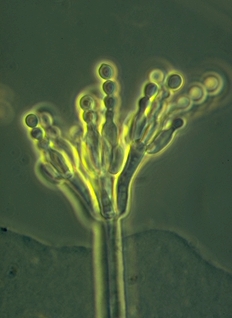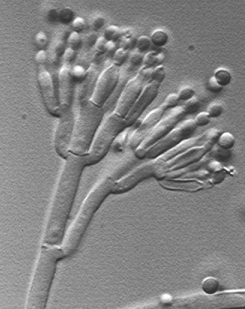


Species of Penicillium are recognized by their dense brush-like spore-bearing structures. The conidiophores are simple or branched and are terminated by clusters of flask-shaped phialides. The spores (conidia) are produced in dry chains from the tips of the phialides, with the youngest spore at the base of the chain, and are nearly always green. Branching is an important feature for identifying Penicillium species. Some (top figure) are unbranched and simply bear a cluster of phialides at the top of the stipe. Others (bottom left) may have a cluster of branches, each bearing a cluster of phialides. A third type (bottom right) has branches bearing a second order of branches, bearing in turn a cluster of phialides. These three types of spore bearing systems (penicilli) are called monoverticillate, biverticillate and terverticillate respectively. Penicillium is a large and difficult genus encountered almost everywhere, and usually the most abundant genus of fungi in soils.
The common occurrence of Penicillium species in food is a particular problem. Some species produce toxins and may render food inedible or even dangerous. It is a good practice to discard foods showing the development of any mould. On the other hand some species of Penicillium are beneficial to humans. Cheeses such as Roquefort, Brie, Camembert, Stilton, etc. are ripened with species of Penicillium and are quite safe to eat. The drug penicillin is produced by Penicillium chrysogenum, a commonly occurring mould in most homes.
Holomorphs: Eupenicillium, Hamigera, Talaromyces, Trichocoma. Ref: Kulik 1968; Pitt 1980; Raper and Thom 1949; Ramirez, 1982; Samson, Stolk, and Hadlok 1976; Stolk and Samson, 1972, 1983



